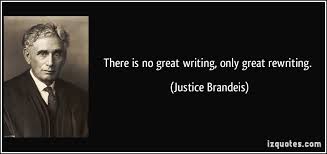Business-Writing Process is Not a Single Flash of Uninterrupted Brilliance — It’s a Hard Slog
Occasionally business writers get it all down in just the right way in a flurry of inspiration. But for most of us writing usually doesn’t happen like that. In fact, the process is commonly a regularly interrupted slog. Ideas come, are written down, rethought, organized, edited, more ideas, refinement, ah-hah moments; dead ends are deleted; we move on, rethink, edit, polish. Repeat several times and maybe you’ll have a great piece.
So don’t think for a minute that creating business prose, copy or documents will be a seamless one-time gig, or that your entire piece will fall out of your head onto the page in a single flash of clarity or brilliance. If you’re waiting for this to happen, you’ll probably get little writing done.
Crafting very good material occurs by not doing it all at once. Writing a little here and a little there actually allows writers to avoid getting hung up. When thoughts aren’t clicking, walking away allows some breathing room for reflection—and a refreshed refocus later (this trick doesn’t necessarily work when working under tight deadlines). This forced-interruption approach can be an effective part of your business-writing process.
Start by writing ideas down—randomly, spontaneously, as the ideas hit. Even if they aren’t quite coherent or connected keep them together and organized in one place. Just writing the ideas down is a process that forces writers to think it through, even if preliminarily. See how the ideas look on the page inspires the process. Though you may not yet be ready to sit down and write the piece, record each idea. Don’t lose ideas. These random and preliminary notes become the foundation for your piece.

With a few ideas to start, you can build the document or article. Seeing ideas on the page triggers more ideas, refinements to the ideas, and lets you think about the writing with the aid of a visual framework. It’s the first step. Then organize, rephrase, expand, adapt, etc. You can leave it any time and come back to it. In fact, you’ll likely find that when you return to work on the piece your thinking is better and clearer—what you’ve started percolates in your mind while you’re away. Eventually, what starts out as a few key ideas expands into a piece engaging and useful to readers.
Don’t be frustrated if what you write doesn’t knock your socks off after the first pass. Good writing requires a lot of (continuous) rewriting. Put the ideas down on paper. Then keep reworking it. You’ll be amazed at how good your writing can be. Mixed up ideas that at first don’t come across right can morph into high meaning and consequence.
It’s your dedication to the business-writing process that makes for great writing.
